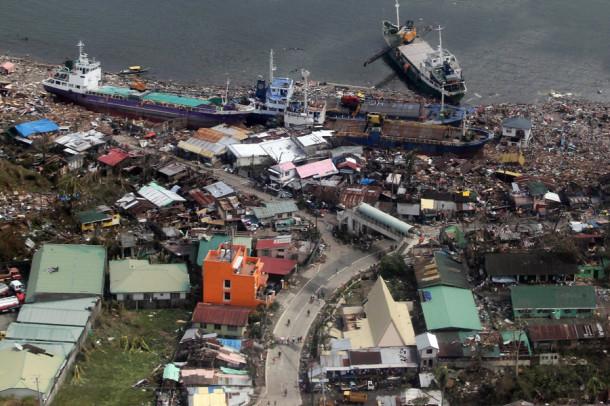International relief teams rush to Philippines in wake of typhoon
Ryan Lim/Xinhua/Zuma Press/MCT
An aerial photo shows the scene after Typhoon Haiyan hit Leyte Province, November 10, 2013. The Philippine government disaster relief agency said Sunday about 4.4 million people have become homeless in areas hit by super typhoon Haiyan (local name Yolanda). The most powerful typhoon in the Philippines in its history, engulfed many areas in Leyte, Eastern Samar, Western and Central Visayas, Bicol and Northern Mindanao regions. (Ryan Lim/Xinhua/Zuma Press/MCT)
(MCT) MANILA, Philippines
With the vast scale of death and destruction slowly coming into focus, international relief teams rushed toward the central Philippines, where one of the strongest storms on record left bereft survivors looting food and water or scrambling for a way out.
Aid agencies said they were hurrying supplies to the area hit early Friday by the typhoon. U.S. Marines were en route from bases in Okinawa, Japan, and U.S. Secretary of Defense Chuck Hagel directed the Pacific Command to deploy helicopters, logistics officers and cargo planes to assist the effort.
Initial reports suggested that the Philippines had escaped widespread loss of life from fast-moving Typhoon Haiyan, called Yolanda by Filipinos. But as reports trickled in Sunday from areas that had been cut off from the rest of the country, it became increasingly clear that the country had suffered a major natural disaster.
The storm weakened over the South China Sea after leaving the Philippines.
In the Philippines, police superintendent Elmer Soria told reporters that officials on the island of Leyte had estimated 10,000 deaths. The U.S. Agency for International Development said that in some parts of the central Philippines, 90 percent of the housing had been destroyed.
“There was death everywhere,” said Danny Larsen, a 35-year-old Dane, who arrived Sunday at a military airbase in Manila from Leyte’s main city, Tacloban.
With few if any cars around and no gas available, Larsen said he walked about 10 miles to the airport from a village where he had ridden out the typhoon in a basement. The road was like “death row,” he said. Multi-story buildings had been reduced to heaps of broken concrete rubble, and bodies were strewn about.
“There were people–babies, children, old people–lying out on the street, with blisters over their bodies … hundreds of them,” said Larsen.
Television footage showed wooden houses in splinters, cars floating on their sides through floodwaters, upended trees and telephone poles and houses with their roofs blown off.
Many of the most desperate remained trapped in remote, mud-choked coastal towns without power, transportation or telephones.
In Tacloban, a city of 220,000, officials said that more than 100 bodies had been found on the airport grounds alone. The homeless and injured crowded around the airport hoping to escape, or at least to find food or fresh water.
Larsen, who had moved to Tacloban two weeks earlier with his girlfriend, said he had waited eight hours with about 1,000 people to get on a cargo plane back to Manila. Their main concern was not the typhoon damage but the lawlessness.
“Everything is being looted. There is no law enforcement; it’s a free-for-all,” he said. “Hotels, everything, cash registers, even McDonald’s. … It is World War III.”
As reports trickled in from more far-flung areas, there were more tales of death and destruction.
“We just made a mass grave for 57 people,” Mayor Edgar Boco from the small coastal town of Hernani told reporters.
While survivors tried to escape, dozens of others in Manila were hoping to catch a ride on a transport plane from Manila’s Villamor Air Base to the scene of the disaster in hopes of finding out what happened to loved ones.
(Special correspondent De Leon reported from Manila and Times staff writer Demick from Beijing. Staff writers Brian Bennett in Washington and Marisa Gerber in Los Angeles, and news agencies contributed to this report.)
(c)2013 Los Angeles Times
Distributed by MCT Information Services






